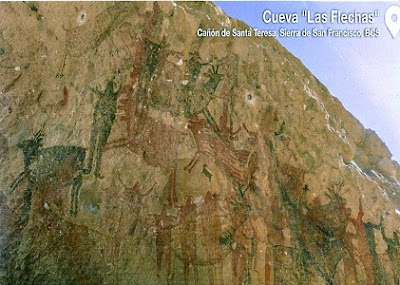I usually get super excited when I receive cards from UNESCO sites but these from Mexico didn't impress me much. The quality of the pictures, the paper, even the cut, isn't that good, it really seems an homemade kind of thing. Homemade or not, there are four sites that I'm not missing anymore.
The three cards with Mexican stamps were sent by Gabino and the other one was sent by Óscar.


Cueva "Las Flechas" is part of the group of cave paintings in the canyon of Santa Teresa in the San Francisco mountain range. The canvas on the rock wall describes some human figures, apparently a female and a male representation. These paintings are among the most visually attractive in the region.
From c. 100 B.C. to A.D. 1300, the Sierra de San Francisco (in the El Vizcaino reserve, in Baja California) was home to a people who have now disappeared but who left one of the most outstanding collections of rock paintings in the world. They are remarkably well-preserved because of the dry climate and the inaccessibility of the site. Showing human figures and many animal species and illustrating the relationship between humans and their environment, the paintings reveal a highly sophisticated culture. Their composition and size, as well as the precision of the outlines and the variety of colours, but especially the number of sites, make this an impressive testimony to a unique artistic tradition. - in: https://whc.unesco.org

El Pinacate and Gran Desierto de Altar Biosphere Reserve (EPGDABR) is located in the Sonoran Desert.
EPGDABR has a surface of 714,566 hectares with 354,871 hectares of buffer zone. It is a large and relatively undisturbed protected area which comprises two very distinct broad landscape types. To the East, there is a dormant volcanic area of around 200,000 ha, comprised of the Pinacate Shield with extensive black and red lava flows and desert pavement. The volcanic shield boasts a wide array of volcanic phenomena and geological formations, including a small shield-type volcano. The most visually striking feature is the concentration of a total of 10 enormous, deep and almost perfectly circular Maar (steam blast) craters.
In the West towards the Colorado River Delta and South towards the Gulf of California, is the Gran Altar Desert, North America's largest field of active sand dunes and only active Erg dunes. - in: https://whc.unesco.org

The Prehistoric Caves of Yagul and Mitla in the central valley of Oaxaca is an extensive cultural landscape that includes caves and shelters, one of which, the Guilá Naquitz cave has provided extraordinarily well preserved botanical evidence of bottle gourds, beans and squash and the earliest known maize cobs, and two others, Cueva Blanca and Gheo Shih siteshave provided evidence of Pleistocene animals and stone tools and the seasonal use of the abundant summer resources of fruit and small mammals.
The gradual shift from social groups based primarily on hunting to ones that were primarily based on settled agriculture took place in multiple areas at the same time across the Mesoamerican region. The property is an exceptional reflection of the evolution from hunter-gathering to more settled communities in this area of the Oaxaca valley. - in: https://whc.unesco.org


Xochicalco is a pre-Columbian archaeological site in the western part of the Mexican state of Morelos. Xochicalco is an exceptionally well-preserved example of a fortified political, religious and commercial centre from the troubled period of 650–900 that followed the break-up of the great Mesoamerican states such as Teotihuacan, Monte Albán, Palenque and Tikal. - in: https://whc.unesco.org


No comments:
Post a Comment